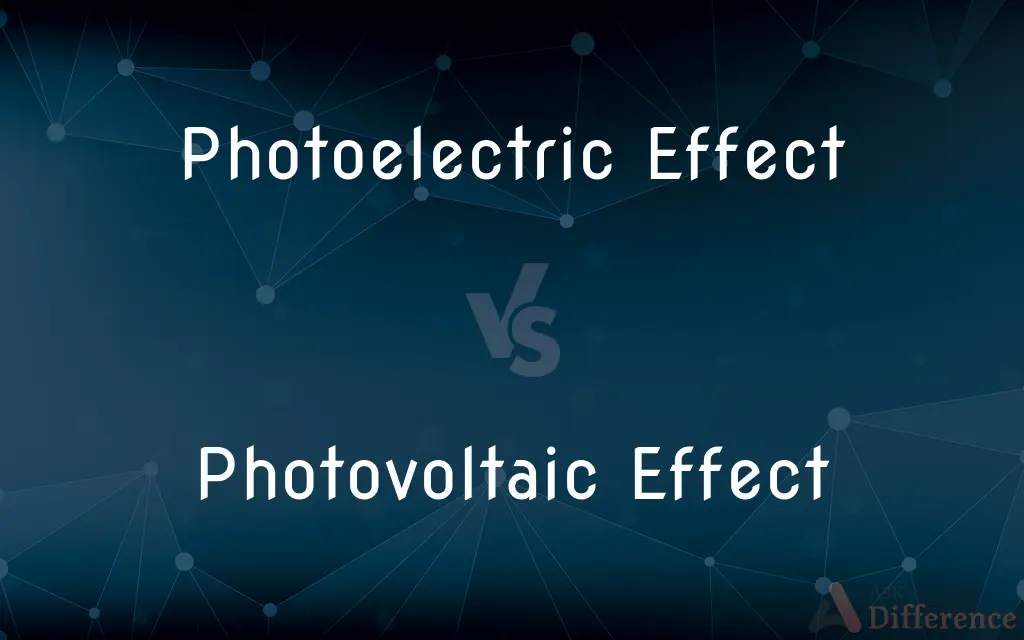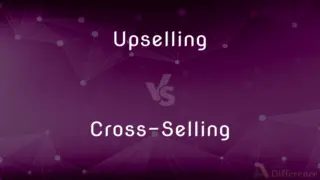Photoelectric Effect vs. Photovoltaic Effect — What's the Difference?
Edited by Tayyaba Rehman — By Fiza Rafique — Published on December 23, 2023
Photoelectric Effect involves ejecting electrons from a material when light strikes, while Photovoltaic Effect generates voltage and current when a material is exposed to light.

Difference Between Photoelectric Effect and Photovoltaic Effect
Table of Contents
ADVERTISEMENT
Key Differences
The Photoelectric Effect and Photovoltaic Effect both pertain to interactions between light and matter. The Photoelectric Effect concerns the ejection of electrons from a material when it's exposed to light of a certain frequency. When light photons strike this material, their energy is absorbed by the material's electrons, causing some electrons to be ejected. This phenomenon, first explained by Albert Einstein, played a significant role in the development of quantum mechanics.
In contrast, the Photovoltaic Effect is related but distinct. It's about the generation of voltage (and current) in a material upon exposure to light. Here, the light photons create electron-hole pairs in a semiconductor. These pairs, if separated by an internal or external electric field, can produce a current. Photovoltaic cells, commonly found in solar panels, employ this effect to generate electricity from sunlight.
While both the Photoelectric Effect and Photovoltaic Effect are quantum-mechanical processes involving the absorption of light photons, their outcomes are different. The former results in the ejection of electrons, while the latter creates a potential difference, or voltage.
One might say the Photoelectric Effect is more about understanding fundamental physics, as it confirmed the particle nature of light. Meanwhile, the Photovoltaic Effect has broader practical applications, particularly in the realm of sustainable energy. Solar panels, which transform sunlight into electricity, are based on the principles of the Photovoltaic Effect.
Lastly, the devices used for studying and utilizing these effects are varied. While photoelectron spectrometers might be employed to observe the Photoelectric Effect, photovoltaic cells are designed to harness the Photovoltaic Effect. The two effects, though closely related in terms of light-matter interaction, have unique characteristics and applications.
ADVERTISEMENT
Comparison Chart
Definition
Ejects electrons when light hits a material
Produces voltage/current when exposed to light
Primary Outcome
Electron emission
Generation of electricity
Practical Applications
Fundamental physics research
Solar panels for power generation
Underlying Principle
Confirmed particle nature of light
Conversion of light into electrical energy
Device Examples
Photoelectron spectrometers
Photovoltaic cells
Compare with Definitions
Photoelectric Effect
Quantum process confirming light's particle nature.
The Photoelectric Effect played a role in the development of quantum mechanics.
Photovoltaic Effect
Generation of voltage in a material upon light exposure.
Solar cells utilize the Photovoltaic Effect to produce electricity.
Photoelectric Effect
Emission of electrons from a material exposed to light.
The metal surface emitted electrons due to the Photoelectric Effect.
Photovoltaic Effect
Converts light energy into electrical energy.
The Photovoltaic Effect allows for direct energy conversion without moving parts.
Photoelectric Effect
Requires light of a certain threshold frequency.
Below the threshold frequency, the Photoelectric Effect is not observed.
Photovoltaic Effect
Creation of electron-hole pairs in semiconductors.
Sunlight hitting the panel causes the Photovoltaic Effect, producing a current.
Photoelectric Effect
Fundamental in understanding electron behavior.
Scientists use the Photoelectric Effect to study electron properties.
Photovoltaic Effect
Driven by the separation of generated electron-hole pairs.
An electric field within the cell enhances the Photovoltaic Effect.
Photoelectric Effect
Observed when photons dislodge material's electrons.
As light intensity increased, more electrons were ejected due to the Photoelectric Effect.
Photovoltaic Effect
Underlies the operation of solar panels.
Due to the Photovoltaic Effect, panels convert sunlight into usable power.
Common Curiosities
How does the Photovoltaic Effect generate electricity?
It produces voltage and current when a material is exposed to light.
Where is the Photovoltaic Effect commonly utilized?
In solar panels to convert sunlight into electricity.
Are the Photoelectric Effect and Photovoltaic Effect the same?
No, they're related but have different outcomes and applications.
What's the primary device that uses the Photovoltaic Effect?
Photovoltaic cells or solar cells.
What happens in the Photoelectric Effect?
Electrons are ejected from a material when exposed to light.
Which effect requires an internal or external electric field?
The Photovoltaic Effect.
What confirmed the particle nature of light?
The observations of the Photoelectric Effect.
How did Einstein contribute to understanding the Photoelectric Effect?
He explained it, confirming the quantized nature of light.
Which effect is fundamental in quantum mechanics?
The Photoelectric Effect.
Why doesn't low-frequency light cause the Photoelectric Effect?
There's a threshold frequency below which the effect isn't observed.
Which effect involves electron-hole pair creation?
The Photovoltaic Effect.
Can any material exhibit the Photovoltaic Effect?
Typically, semiconductors are used for the Photovoltaic Effect.
Are both the Photoelectric and Photovoltaic Effects quantum processes?
Yes, both involve quantum-mechanical interactions between light and matter.
Why are solar panels important for sustainable energy?
They use the Photovoltaic Effect to convert sunlight directly into electricity.
What device measures the Photoelectric Effect?
Photoelectron spectrometers.
Share Your Discovery

Previous Comparison
Sauté vs. Stir Fry
Next Comparison
Upselling vs. Cross-SellingAuthor Spotlight
Written by
Fiza RafiqueFiza Rafique is a skilled content writer at AskDifference.com, where she meticulously refines and enhances written pieces. Drawing from her vast editorial expertise, Fiza ensures clarity, accuracy, and precision in every article. Passionate about language, she continually seeks to elevate the quality of content for readers worldwide.
Edited by
Tayyaba RehmanTayyaba Rehman is a distinguished writer, currently serving as a primary contributor to askdifference.com. As a researcher in semantics and etymology, Tayyaba's passion for the complexity of languages and their distinctions has found a perfect home on the platform. Tayyaba delves into the intricacies of language, distinguishing between commonly confused words and phrases, thereby providing clarity for readers worldwide.
















































